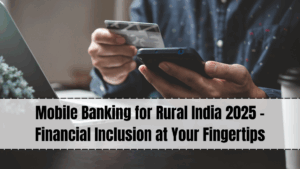In 2025, mobile banking has emerged as one of the most powerful tools for bridging India’s urban-rural financial divide. While banking services in urban centers have long been digitalized, rural communities historically faced challenges such as limited bank branch access, inadequate financial literacy, and poor infrastructure. Today, the combination of affordable smartphones, improved internet connectivity, and innovative fintech solutions has brought banking directly into the hands of rural citizens. This shift is not just about convenience—it is a vital step toward financial empowerment, economic growth, and social inclusion for millions of Indians living in villages and small towns.

The Need for Mobile Banking in Rural India
India’s rural population accounts for more than 65% of the country’s total population, yet for decades, large sections of this demographic were excluded from formal banking systems. Factors such as long travel distances to bank branches, cumbersome documentation processes, and lack of awareness made it difficult for rural residents to open accounts or access credit. The government’s initiatives, such as Jan Dhan Yojana, laid the groundwork for financial inclusion by encouraging account openings, but true accessibility only came when mobile banking allowed these services to reach people wherever they were.
Key Features of Mobile Banking for Rural Users
Mobile banking platforms in 2025 are designed with simplicity, local context, and inclusivity in mind. The most notable features include user interfaces in multiple regional languages, voice-command banking for those with limited literacy, and biometric login for added security. Customers can check balances, transfer money, pay utility bills, and receive government subsidies directly into their accounts through mobile applications. Offline banking modes, which allow transactions via USSD codes or SMS without requiring an internet connection, ensure access even in remote areas with weak network coverage.
Digital Payments and Daily Transactions
Digital payments have become a key driver of mobile banking adoption in rural India. QR code-based payments, UPI (Unified Payments Interface), and Aadhaar-enabled payment systems allow small shopkeepers, farmers, and service providers to accept cashless transactions with minimal setup costs. This cashless movement reduces the risk of theft, lowers dependency on physical currency, and improves transparency in local economies. Farmers can now sell produce directly to buyers and receive instant payments, cutting out middlemen and increasing their earnings.
Access to Credit and Microloans
One of the most transformative aspects of mobile banking in rural India is the ability to apply for and receive microloans digitally. Traditional banks often hesitated to lend to rural residents due to a lack of formal credit history. However, AI-powered credit scoring models now evaluate alternative data such as mobile transaction history, savings patterns, and even utility bill payments to assess creditworthiness. Small farmers can access quick loans for seeds, fertilizers, or equipment, while rural entrepreneurs can fund small businesses without lengthy approval processes. These loans are often disbursed within hours and repaid through flexible mobile payment schedules.
Government and Private Sector Collaboration
The rapid adoption of mobile banking in rural areas has been fueled by strong collaboration between government agencies, banks, and fintech companies. Government schemes ensure subsidies and welfare payments are sent directly to beneficiaries’ accounts, eliminating corruption and delays. Public sector banks partner with fintech startups to offer mobile-first banking services, while mobile network providers work to improve connectivity in underserved regions. Training programs led by NGOs and self-help groups also educate rural citizens on safe banking practices and fraud prevention.
Security and Trust Building
While mobile banking offers convenience, concerns around fraud and cybersecurity remain. In response, 2025’s mobile banking solutions include multi-factor authentication, AI-driven fraud detection, and real-time transaction alerts. Biometric verification using fingerprints or facial recognition ensures that accounts cannot be accessed without consent. Rural banking agents play a critical role in trust-building by guiding customers through transactions, helping them understand app features, and addressing fears around digital fraud.
Challenges in Expanding Mobile Banking
Despite the progress, several challenges still hinder mobile banking adoption in rural India. Intermittent internet connectivity in some regions continues to be a barrier, although offline transaction options are helping to bridge this gap. Low levels of financial literacy in certain communities mean that awareness campaigns remain essential. Additionally, elderly populations may be hesitant to adopt mobile technology, requiring extra guidance and support. Finally, device affordability is a concern for the lowest-income households, though falling smartphone prices and government subsidies are steadily improving access.
The Future of Rural Mobile Banking
By 2030, mobile banking in rural India is expected to become the primary form of banking, replacing the need for frequent in-person branch visits. Integration with AI-powered financial assistants will allow users to receive personalized savings advice, investment options, and loan recommendations directly through their mobile devices. More advanced biometric security, such as voice recognition, will make digital transactions even safer. As rural communities embrace cashless transactions, their participation in the broader digital economy will accelerate, contributing to higher household incomes and regional economic growth.
Global Context and Inspiration
India’s rural mobile banking revolution is attracting global attention, with countries in Africa, Southeast Asia, and Latin America studying its success. Similar models are being replicated in Kenya, Bangladesh, and Indonesia, where mobile wallets and digital microfinance services are boosting financial inclusion. India’s large-scale adoption demonstrates how technology, when paired with policy support and community education, can transform millions of lives.
FAQs
How does mobile banking help rural communities?
It provides access to essential banking services such as money transfers, bill payments, and loans without requiring travel to physical bank branches.
Can mobile banking work without internet?
Yes. Offline banking modes using USSD codes or SMS allow basic transactions without internet connectivity.
Are rural mobile banking transactions safe?
Yes. With biometric authentication, multi-layer encryption, and AI fraud detection, rural mobile banking is highly secure.
How do rural citizens learn to use mobile banking?
Training programs by banks, NGOs, and local community groups teach citizens how to operate apps, recognize scams, and perform secure transactions.
Click here to know more.
